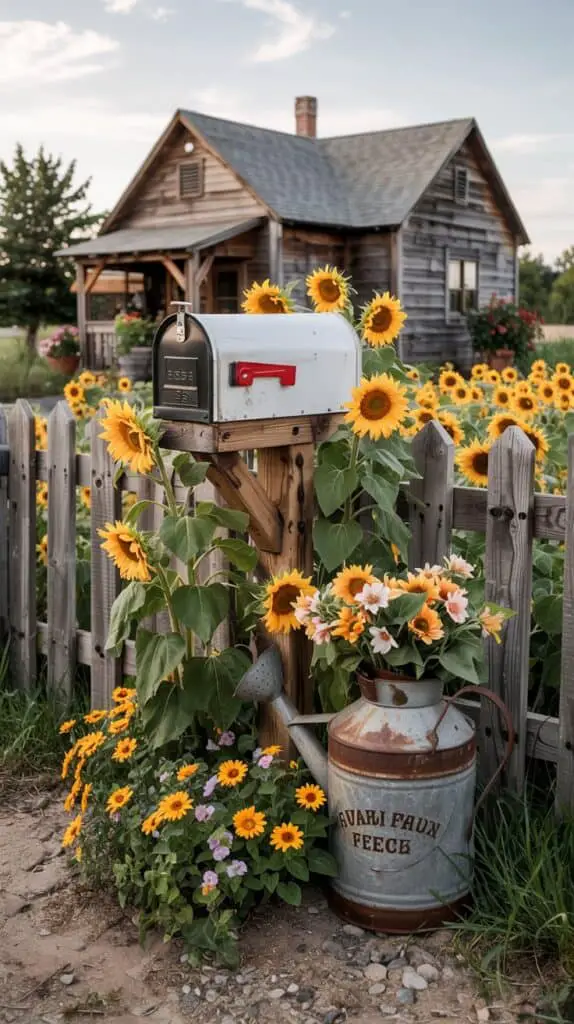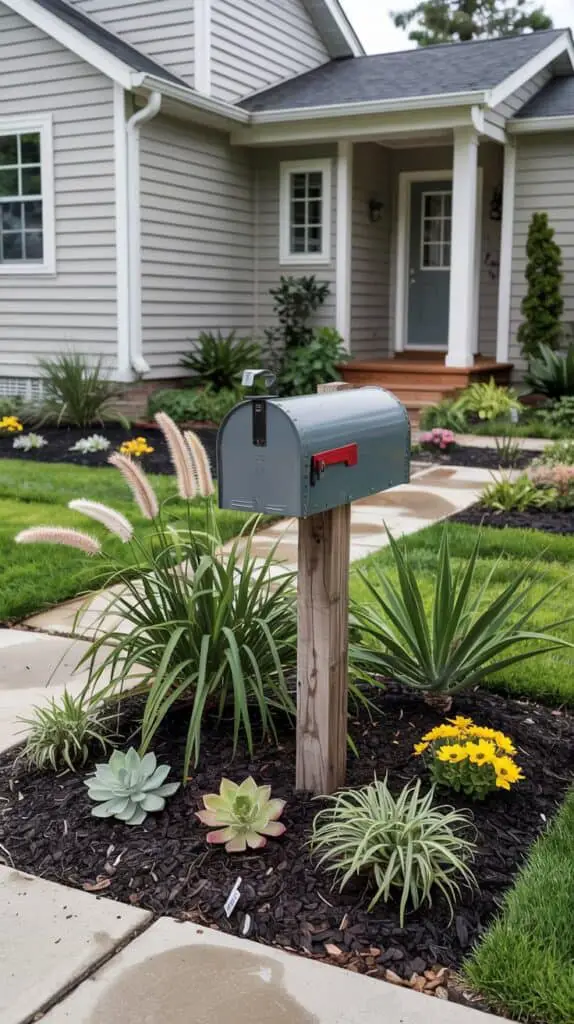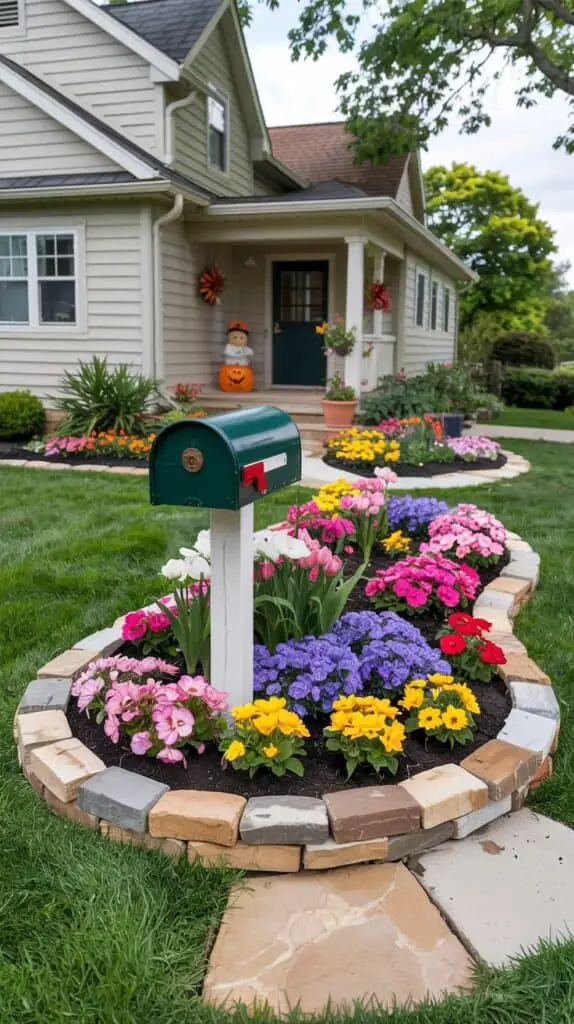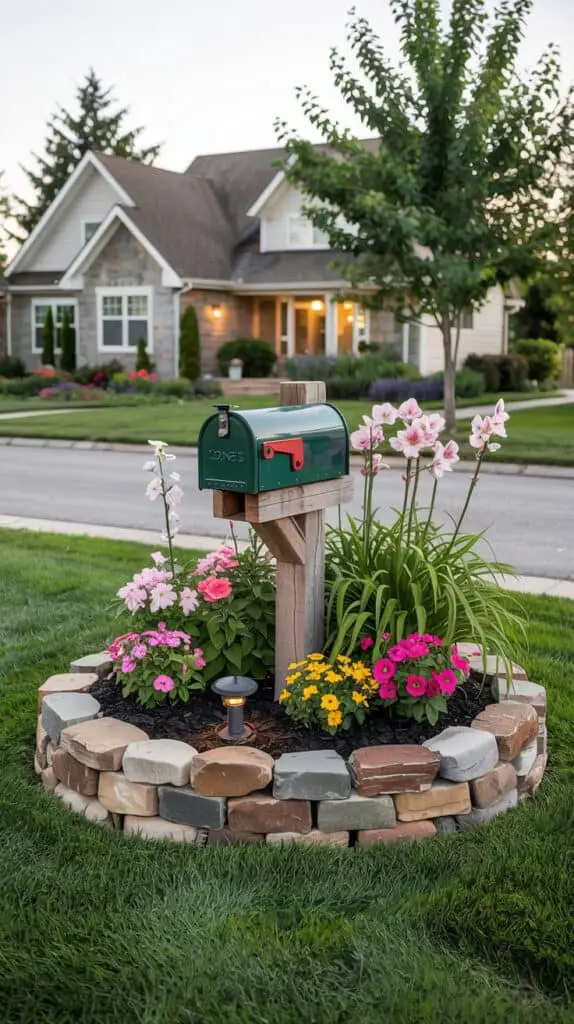
Let’s be honest—our mailbox is usually the most forgotten part of the front yard. It’s stuck out there collecting bills, birthday cards, and takeaway menus, and meanwhile it’s not really adding much to your curb appeal. But it could be. I mean, if you’ve already gone to the effort of tidying up the porch and planting your window boxes, doesn’t it make sense to give the mailbox its moment too?
I only started thinking about ours after a neighbor turned hers into this adorable little flower patch. Just some stones around the base, a few petunias and black-eyed Susans, and suddenly the whole entrance to her driveway looked bright and inviting. I was a bit jealous, not gonna lie. And then I thought—hang on, this is actually doable. It doesn’t need a full landscaping team or hundreds of dollars. A few plants, a bit of edging, and a plan. That’s all.
So whether you’ve got a classic farmhouse, a brick suburban home, or something in-between, these mailbox flower bed ideas are totally family-friendly, easy to copy, and actually pretty fun to put together on a weekend with the kids or a cup of iced tea in hand.
Cottage-Inspired Mailbox Garden with Lavender and Brick Edging

If your home leans slightly cottage or vintage, a mailbox flower bed filled with lavender, creeping thyme, and pink cosmos is the perfect soft touch. The key here is to make it look like it just naturally grew that way—nothing too stiff or pruned.
Start with a small circular bed around the base of the post, bordered by old bricks or natural stone. Fill it with a mix of low-growing herbs and wildflower-style plants. Lavender adds that signature cottage smell, and it’s low maintenance too. You can also add a few trailing alyssum or lobelia for softness around the edges.
This works well for country houses, gravel driveways, or even newer builds where you want to add a bit of character. Bonus? Bees will love it, and the kids will probably find a ladybug or two hiding in there.
Raised Mailbox Bed with White Gravel and Boxwood Accents

For a cleaner, slightly more modern take, try a raised square or rectangular bed made with timber or stone, filled with white gravel and some neat green boxwoods. It gives the mailbox area a tidy, intentional look—almost like an entry feature.
You’ll want to elevate the bed a few inches and line the inside with landscape fabric to keep things neat. Plant a mix of dwarf boxwoods in a triangle layout, or line the back edge with taller ornamental grass for height. You can even pop in a solar light or two for a soft glow at night.
This one suits suburban houses with straight-line driveways and tidy lawns. It’s also great if you don’t want to fuss too much with deadheading flowers—boxwoods just need the occasional trim and they look great year-round.
Classic Farmhouse Mailbox with Sunflowers and Rusty Milk Can

There’s something timeless about a wooden post mailbox surrounded by cheerful sunflowers and old metal accents. This one leans all the way into that rural, vintage, down-to-earth charm. It feels like something you’d see driving past a field in late July.
Start by planting a semicircle bed behind and around the mailbox post, using sunflower varieties like ‘Teddy Bear’ or ‘Lemon Queen’ so they don’t get too massive. At the front, layer in smaller blooms like marigolds or zinnias for a full, warm look. If you can get your hands on an old milk can or watering can, place it beside the post and fill it with trailing ivy or faux blooms.
This design looks amazing against clapboard houses, gravel paths, and picket fences. It’s definitely a showstopper and gives off “yes we bake pies here” energy—even if you absolutely do not.
Low-Maintenance Mailbox Garden with Ornamental Grasses and Mulch

Maybe flowers aren’t your thing. Or maybe you just don’t have the time (or energy) to water and trim them every week. Totally fair. This idea is for families who want something polished but super easy to keep alive.
Think textures, not blooms. Use dark mulch as the base, and plant a few fountain grasses, dwarf feather reed grass, or blue fescue around the post. For variety, you can add a few succulents or decorative stones between the plants. It’s super low fuss but still looks finished and well-designed.
This one fits newer homes, minimalist yards, and front gardens where you don’t want anything that looks too busy. It also plays really nicely with more neutral house colors like gray, beige, or white.
Wraparound Flower Bed with Seasonal Color Swaps

If you love changing things up for the seasons—or if you’re just indecisive like me—this idea is perfect. Build a wide, wraparound bed around the base of the mailbox with room for swapping out plants. It’s a flexible setup that evolves with your mood or the month.
Use a stone or wooden border to shape a teardrop or oval bed. In spring, fill it with tulips and daffodils. In summer, swap in impatiens, geraniums, or salvia. Fall? Mums and ornamental kale. You can even tuck in a little Halloween decoration or mini scarecrow when October rolls around.
This layout is best for front yards that get some decent sun and for families who don’t mind playing in the dirt a few times a year. It’s playful, always fresh, and keeps things interesting for the neighbors too.
Country Mailbox Bed with Wildflowers and Weathered Wood

If your home sits near a field, wooded edge, or long country lane, a wildflower-style mailbox bed blends right in—and feels like part of the landscape rather than a standalone garden feature. This one’s all about a bit of chaos in the best way.
Use a square or free-form shape and skip the rigid edging. Scatter wildflower seed mixes or plant favorites like coneflowers, black-eyed Susans, bee balm, and blanket flowers. They don’t need much fussing, and once they’re established, they pretty much take care of themselves. Around the base, you can lean in an old wood crate or nail a birdhouse to the side of the post for added charm.
It’s a great choice if you want something natural, family-friendly, and buzzing with life. And the bonus? It’s super pollinator-friendly, which kids will love. One year my daughter counted 17 bees and three butterflies before breakfast—beats cartoons, I reckon.
Stone-Edged Mailbox Island in a Large Front Lawn

For homes with big front yards or long driveways, an island-style mailbox bed makes a lot of visual sense. It turns the mailbox into a real feature—something centered and intentional rather than lost in the grass.
Start by carving out a rounded or oval-shaped bed around the mailbox and lining it with larger natural stones or short retaining wall blocks. Inside, layer tall plants in the back (like daylilies or hollyhocks), medium-height fillers like coreopsis or salvia, and short groundcovers like creeping Jenny or vinca at the front edge. Add a layer of dark mulch and maybe a solar spotlight for evening glow.
This setup works best in wider front yards, especially those with circular driveways or extra lawn space. It’s bold, eye-catching, and doesn’t feel cluttered even with taller plants.
Suburban Mailbox Bed with Annual Color and Kids’ Touches

If you’ve got little ones and live in a family-filled neighborhood, why not make your mailbox area a shared creative space? This version is simple, cheerful, and changes up every season—plus, the kids can help pick the flowers.
Use a small circular bed with simple edging (timber or flexible plastic works fine) and fill it with kid-friendly annuals: think snapdragons, pansies, or even strawberries. Let them paint a few small garden stones or add a miniature flag for holidays. One year, we even stuck in a tiny scarecrow made out of popsicle sticks—it didn’t last long, but it was cute while it did.
This works well for modest front yards, suburban sidewalks, or even rental homes where you want to keep it light, fun, and not too permanent. And trust me, there’s nothing like seeing your child proudly point out their flower “design” to the postman.
Elegant Brick Mailbox with a Formal Floral Border

If your house has more of a formal or classic design—maybe a brick exterior or a traditional two-story layout—you can match that with a structured flower bed that’s tidy but still warm and inviting.
This design pairs beautifully with a brick or stone mailbox column. Build a small square or rectangle bed at the base, and plant neat rows or symmetrical groupings: white begonias, purple petunias, or neatly trimmed dwarf azaleas. Line the border with landscape edging stones and top it with fresh brown mulch. It’s simple, clean, and really polished.
This kind of mailbox landscaping gives off “well cared-for home” energy, and it looks fantastic year-round—just rotate in a few seasonal annuals or evergreen dwarf shrubs to keep it looking fresh.
Natural Look Mailbox Bed with River Rocks and Ferns

Got lots of shade or a front yard full of trees? You can still make a stunning flower bed by leaning into the natural woodland look. This setup avoids big colorful blooms and instead uses texture, layers, and earthy tones to add interest.
Start with a wide, soft-edged bed around the post. Fill it with hardy shade plants like hostas, ferns, coral bells, and a few clumps of ornamental grass. Weave in river rocks, driftwood pieces, or even a few mossy stepping stones for that quiet forest vibe.
This idea works great for older homes, woodland lots, or homes built into sloped land or hillsides. It’s calm, peaceful, and doesn’t scream for attention—but when you notice it, it’s genuinely lovely. And it’s super low-maintenance once the plants are settled in.
Final Thoughts
So there you have it—a little bit of mailbox magic for every kind of home and family vibe. Whether you’re into wildflowers, formal lines, or just want something your toddler can help with, there’s a mailbox flower bed here for you. These small spaces are honestly the easiest way to dip your toes into landscaping without committing to a full-blown garden project.
And the best part? Every letter, parcel, and birthday card you get from now on will be delivered with a side of flowers. Can’t complain about that.
